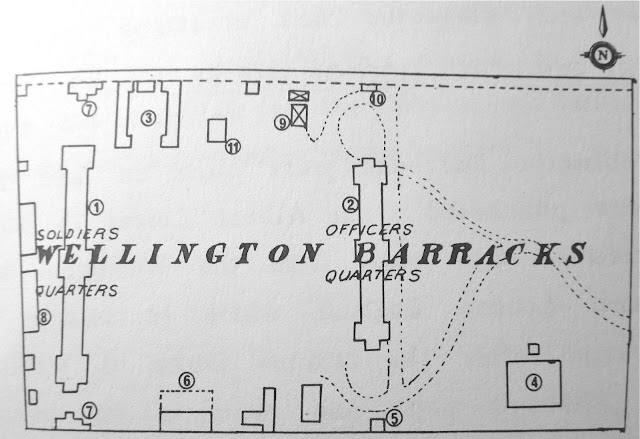Dad's Navy Days, 1941 - 1945
By G. A. Harrison
Mess A, Sailors' Quarters at Wellington Barracks Complex, HMCS Stadacona
Introduction: The following post will be part of a Nov. 2016 presentation regarding my father's WW2 service with the RCNVR and Combined Operations organization.
MY DAD'S NAVY DAYS
Part 3 - Halifax Training is Tough, Combined Operations Even Tougher
Before I share information about early landing craft training undertaken in the UK by the first Canadians in Combined Ops, I would like to touch on information regarding Canadian Commandos in Combined Operations, and report a bit more information I've learned about early training facilities in Canada linked to the origins of Combined Operations.
Firstly, in his memoirs my father wrote about his early training in Halifax, from October - December, 1941, but in his opening remarks he refers to returning to Canada (after two years in wartime Europe) and discovering there were Canadians about to leave Halifax for Europe as Commandos.
He writes:
It would be fitting here to say, to whatever camp or ship we went - and we were at many (i.e., from Jan 1942 - Dec. 1943) we were called new entries. Even after two years overseas, when we arrived back at Halifax (aboard the HMS Aquitania in Dec. 1943) and fell in, the first words we heard were "for the benefits of you new entries." How humiliating can they get? Then you got the rules.
We met a lot of sailors (upon our return) who were shortly to go through what we went through already, and they called themselves commandos. They sure were in for a rude awakening.
I take his words to mean that while he was overseas he had not met any Canadian Commandos there. From my own readings I am pretty sure he did some of the same training as British Commandos, perhaps trained with them while in the UK, and transported American Rangers (similar in ways to British Commandos) on landing craft, e.g., upon LCMs in North Africa. When Canadian Commandos appeared on the scene and where they first served in Europe is not clear to me at this time. Perhaps my father mentions the "rude awakening" because the real battlefield was much different than training back at home, e.g. in Halifax.
He goes on to say:
We were never called commandos, only combined operations ratings, and we were the first from Canada to go overseas.
Though my father's shoulder patch bore the same insignia as the Commandos he trained with, perhaps served with, he makes clear that when he left Halifax for Europe two years earlier he was RCNVR and Combined Ops only. Those learning more about Comb. Ops, as I am, can now look for Canadians with three designations, i.e., RCNVR ('sailors', as Dad says above), Combined Ops, and Commandos (likely W Commandos).
Please start here: The memoirs of Peter Neuman, Canadian Commando, graciously supplied by his son William, on this website.
And secondly, about early training facilities in Canada linked to Combined Operations - there may be twists and turns encountered as people search for details.
That there was a Combined Operation training ground on Vancouver Island, on The Spit" at Comox, 1943 - 1946 is clear and documented. More details will be supplied later about that establishment. However, because so little documentation exists that links the first Canadian Combined Ops volunteers to HMCS Stadacona and Wellington Barracks, I will add a photo or two that will establish that link more firmly. (This is in the wake of being told that RCNVR did not train at HMCS Stadacona, but at HMCS Cornwallis*, by a staff member of the Admiralty House Museum, housed on Stadacona's grounds).
Written confirmation is supplied in an earlier part of the presentation. Two RCNVR recruits speak of their time at Stadacona and Wellington barracks in late 1941. See Presentation: My Dad's Navy Days Part 1
Pictorial confirmation:
Top half of diagram shows 'Soldiers Quarters' (aka Mess A, left) facing 'Officers
Quarters' (Mess B, across Parade ground). From 'A Brief History of Wellington
Barracks', distributed by Admiralty House Museum, south of barracks
'Soldiers' Quarters. Stately, with rounded brickwork at front of first level
The men's quarters were known as Nelson Barracks as late as 1940.
Photo - Sailor Remember by W. H. Pugsley, page 8
From photo files at Admiralty House Museum
Effingham Division, 1941. Surroundings do not reveal their location
Some of the same group before full assembly. Wellington Barracks in background.
Caption reads: Taken at Halifax of the First Draft (some missing, picked up later)
of Canadian Combined Operations before they left for the Canadian base,
HMCS Niobe, Scotland. From St. Nazaire to Singapore, Volume 1, pg. 25
"Doug and Mac at Halifax, 1941" Note background left.
Unnamed recruits. Note background left.
Photo - The Memory Project
"In 1948 the decision was made to demolish 'A' Mess" (Soldiers Quarters)
Though Wellington Barracks Mess A is gone, it is not forgotten
"In 1941, negotiations were completed for the transfer of Wellington Barracks to the Royal Canadian Navy. With the acquisition of Wellington barracks, Nelson Barracks now became HMCS Stadacona, the base depot."
And in 1941, I say it was inhabited by a number of raw but ready recruits, low on landing craft skills but ready to volunteer for hazardous overseas duties - as long as their mates signed up as well!
More to follow.
**"the training establishment officially moved to the new base from HMC Dockyard on April 14, 1943". Link to CFB Cornwallis, wikipedia
Please link to Presentation: Dad's Navy Days 3 (2)











No comments:
Post a Comment